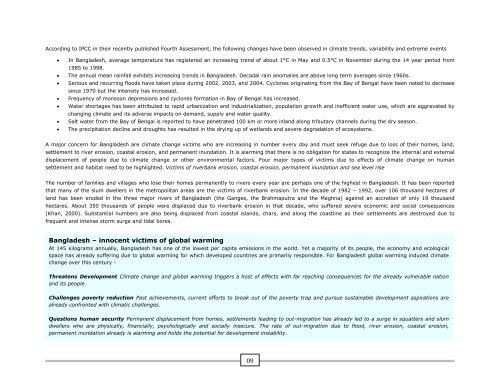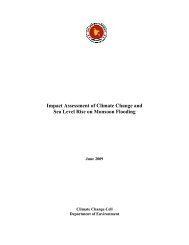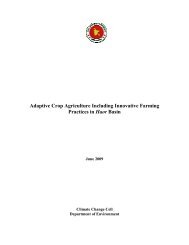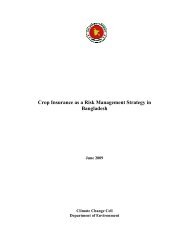CLIMATE CHANGE AND BANGLADESH
CLIMATE CHANGE AND BANGLADESH
CLIMATE CHANGE AND BANGLADESH
You also want an ePaper? Increase the reach of your titles
YUMPU automatically turns print PDFs into web optimized ePapers that Google loves.
According to IPCC in their recently published Fourth Assessment, the following changes have been observed in climate trends, variability and extreme events<br />
• In Bangladesh, average temperature has registered an increasing trend of about 1°C in May and 0.5°C in November during the 14 year period from<br />
1985 to 1998.<br />
• The annual mean rainfall exhibits increasing trends in Bangladesh. Decadal rain anomalies are above long term averages since 1960s.<br />
• Serious and recurring floods have taken place during 2002, 2003, and 2004. Cyclones originating from the Bay of Bengal have been noted to decrease<br />
since 1970 but the intensity has increased.<br />
• Frequency of monsoon depressions and cyclones formation in Bay of Bengal has increased.<br />
• Water shortages has been attributed to rapid urbanization and industrialization, population growth and inefficient water use, which are aggravated by<br />
changing climate and its adverse impacts on demand, supply and water quality.<br />
• Salt water from the Bay of Bengal is reported to have penetrated 100 km or more inland along tributary channels during the dry season.<br />
• The precipitation decline and droughts has resulted in the drying up of wetlands and severe degradation of ecosystems.<br />
A major concern for Bangladesh are climate change victims who are increasing in number every day and must seek refuge due to loss of their homes, land,<br />
settlement to river erosion, coastal erosion, and permanent inundation. It is alarming that there is no obligation for states to recognize the internal and external<br />
displacement of people due to climate change or other environmental factors. Four major types of victims due to effects of climate change on human<br />
settlement and habitat need to be highlighted. Victims of riverbank erosion, coastal erosion, permanent inundation and sea level rise<br />
The number of families and villages who lose their homes permanently to rivers every year are perhaps one of the highest in Bangladesh. It has been reported<br />
that many of the slum dwellers in the metropolitan areas are the victims of riverbank erosion. In the decade of 1982 – 1992, over 106 thousand hectares of<br />
land has been eroded in the three major rivers of Bangladesh (the Ganges, the Brahmaputra and the Meghna) against an accretion of only 19 thousand<br />
hectares. About 350 thousands of people were displaced due to riverbank erosion in that decade, who suffered severe economic and social consequences<br />
(Khan, 2000). Substantial numbers are also being displaced from coastal islands, chars, and along the coastline as their settlements are destroyed due to<br />
frequent and intense storm surge and tidal bores.<br />
Bangladesh – innocent victims of global warming<br />
At 145 kilograms annually, Bangladesh has one of the lowest per capita emissions in the world. Yet a majority of its people, the economy and ecological<br />
space has already suffering due to global warming for which developed countries are primarily responsible. For Bangladesh global warming induced climate<br />
change over this century -<br />
Threatens Development Climate change and global warming triggers a host of effects with far reaching consequences for the already vulnerable nation<br />
and its people.<br />
Challenges poverty reduction Past achievements, current efforts to break out of the poverty trap and pursue sustainable development aspirations are<br />
already confronted with climatic challenges.<br />
Questions human security Permanent displacement from homes, settlements leading to out-migration has already led to a surge in squatters and slum<br />
dwellers who are physically, financially, psychologically and socially insecure. The rate of out-migration due to flood, river erosion, coastal erosion,<br />
permanent inundation already is alarming and holds the potential for development instability.<br />
09





